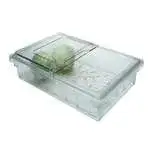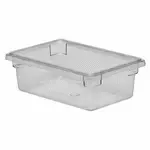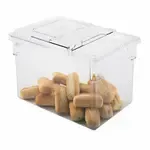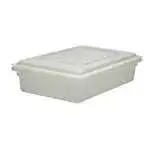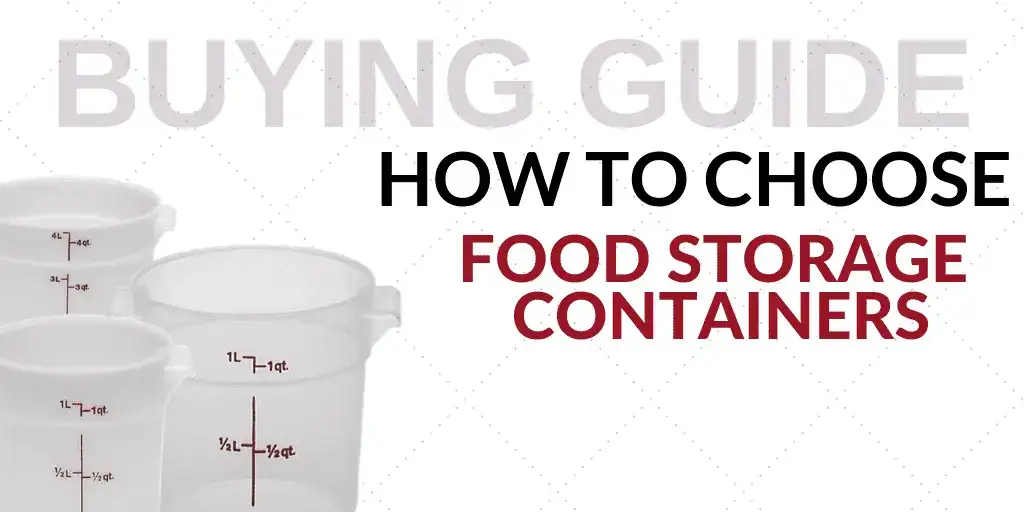
Buying Guide: How to Choose Food Storage Containers for Your Foodservice Establishment
Essential to any commercial kitchen, food storage containers keep bulk dry food products covered and contained for food safety and organizational purposes. Because of their versatility, these containers are available in a variety of types, sizes, shapes, and other specifications. Here’s a quick guide to help you decide which ones will work best for your needs, kitchen setup, and ingredients.
Materials
You’ll notice when shopping for storage containers that there are minute color and opaque differences visible to the naked eye. In fact, there are three primary material compositions to keep aware of when searching through our inventory:
Polycarbonate
This clear material is shatterproof and offers the benefits of fast identification of contents as well as prolonged ingredient longevity. They can withstand temperatures ranging from -40 degrees upwards of 210 degrees Fahrenheit.
Pros: resists food acids and oils for maintained clarity over time.
Polypropylene
Translucency offers the benefits of fast identification of contents. They’re an economical choice, providing a 100% BPA-free food contact surface. They can withstand temperatures ranging from -40 degrees to about 160 degrees Fahrenheit.
Pros: if you’re not needing excessive heat resistance, then this option is more cost-effective for storage as compared to polycarbonate counterparts.
Polyethylene
100% BPA-free, these white containers are durable and come with typically the lowest price tags. They can withstand temperatures from -40 to 160 degrees Fahrenheit.
Pros: good for both cold and dry food storage and durable and cheap.
Shapes and Sizes
Food storage containers generally come in one of two shapes:
Round
Pros: promotes proper air circulation, faster cooling times, minimizes food waste.
Cons: doesn’t fit against other products or in corners easily.
Square
Pros: maximizes storage space and hold more product in smaller amounts of space.
Cons: can be harder to clean inside the cavity at corners.
Additional Features
Unique to certain containers and manufacturers are special features that you can opt to include in order to improve your use of your food storage containers. Here are some notable features to keep in mind:
- Lids: Enabling you to keep contents fresh and sealed, lids can be purchased in addition to the containers themselves.
- Seal Cover Lids: These are tight-fitting, spill-resistant lids with an inner and outer seal, allowing one to tip the container completely upside-down without spillage.
- Snap-On Lid: If you’re not at risk for bumps and accidents, then a less costly snap-on lid might be just the answer. With an airtight fight and spill-resistant design, these are not always guaranteed to prevent leakage should a container tip.
- Color-Coded Lids: Many containers can be equipped with colored lids for easy identification of products. These are especially ideal for white or opaque containers where one would have to remove the lid to identify the contents.
- Measurements: Many containers come with pre-printed measurements on the side of the container for fast identification of how much product is left within the cavity. This is especially helpful for speeding up purchasing lists and orders.
- Stackability: When not in use, containers from the same brand can nest within one another for easy storage. When in use, lugs and lids help users to stack containers atop one another for space-saving purposes.
Food Storage Boxes
Like containers, food storage boxes help to keep ingredients fresh and organized. They’re available in the same material compositions but tend to lay flatter than their container counterparts with different available sizes. Color-coded food storage boxes offer a color-coded system to eliminate cross-contamination, making them ideal for keeping raw meats separate from ready-to-eat foods or other stored food products.
There are additional features and accessories to food storage boxes as well:
- Colander Pans: slipping easily into the box, colander pans drain liquids away from products like produce.
- Drain Trays: these are similar to colander pans and allow liquids to drain away from products within the storage box.
- Lids: these are available with many of the same features as lids for storage containers but do not have the same leak-proof seals available in lid options for containers. Food storage box lids are available in standard flat varieties, as well as sliding and flip top designs and allow for employees to open only one half of the cover at any given time rather than uncovering the entire opening of the box.
Ingredient Bins
Dry ingredients like flours, rice, and other bulk goods can be stored in ingredient bins for easier access while still being protected from contaminants.
- Capacity: to help conserve floor space, many rolling ingredient bins are designed with more vertically-inclined capacities. First, you’ll want to understand how much of any given ingredient you use on a regular basis (as you don’t want to store your ingredients in ingredient bins for extended periods of time - remember, these are considered a temporary housing unit for your ingredients).
- Shape: after you have a better understanding of the capacity that you’ll need for your bins, then it’s time to analyze how the shapes of the bins will fit together with the design of your kitchen. Many can be rolled underneath a stainless steel table or worktop for easy access, and some are shaped to fit in the nooks and crannies of your shelving units as well.
- Stack’ability: some ingredient bins are designed so that they can work together with one another, having the ability to stack atop each other for a more customizable storage experience. If you have many dry ingredients that don’t require large capacities (like rolling trashcan bins, for instance), then it may be easier to look into smaller stacking bins for your prep areas.
- Roll’ability: and if you’re needing your ingredient bins to hold more pounds of goods, then you’re likely starting to look into ingredient bins that come with casters. These are best for rolling under those work surfaces for easy access and simple storage abilities.
At the end of the day, it’s a combination of all of these details that will help determine which ingredient bins work best for your kitchen and your needs. Having bulk ingredients available in easily-accessible bins can improve workplace efficiency and workflow, helping to bring bulk products within grasp of prep cooks.

